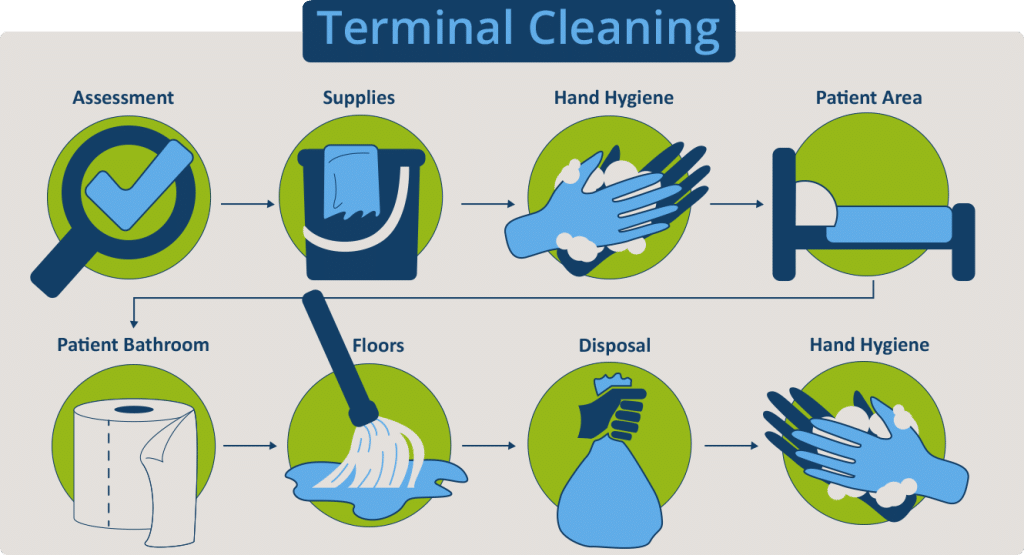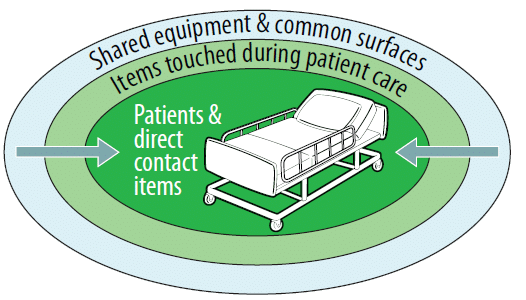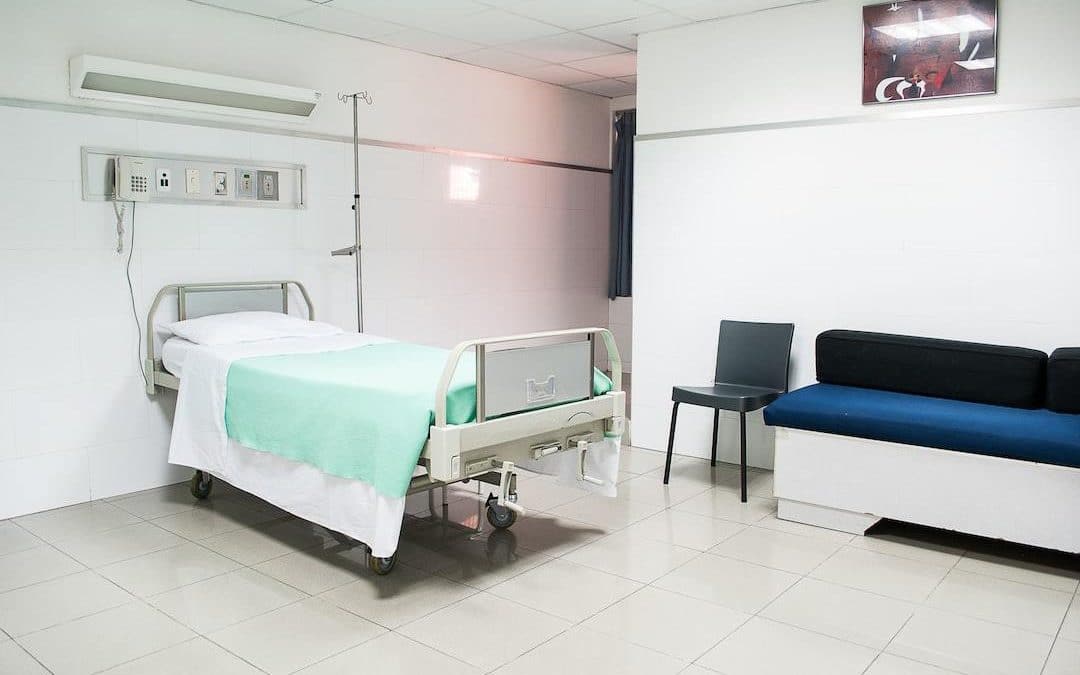The Centers for Disease Control (CDC) defines terminal cleaning as a thorough disinfecting process for surfaces possibly contaminated with pathogens in healthcare settings.
This deep-cleaning method goes beyond the surface to tackle high-touch areas and hard-to-reach corners that might harbor pathogens. Terminal cleaning is highlighted by the CDC as an essential part of infection control protocols.
In this post, we will dive into the specifics of terminal cleaning. We’ll cover everything from the necessary tools, and crucial safety precautions to the global standards that shape these processes.
Table Of Contents:
- What is Terminal Cleaning?
- Terminal Cleaning Protocol
- Tools and Equipment for Terminal Cleaning
- Safety Measures in Terminal Cleaning
- Standards and Guidelines for Terminal Cleaning
- Selecting a Terminal Cleaning Service Provider
- The Future of Terminal Cleaning
- FAQs in Relation to Terminal Cleaning
- Conclusion
- 360clean’s Terminal Cleaning
- What is Terminal Cleaning?
- Terminal Cleaning Protocol
- Tools and Equipment for Terminal Cleaning
- Safety Measures in Terminal Cleaning
- Standards and Guidelines for Terminal Cleaning
- Selecting a Terminal Cleaning Service Provider
- The Future of Terminal Cleaning
- FAQs in Relation to Terminal Cleaning
- Conclusion
- 360clean’s Terminal Cleaning
What is Terminal Cleaning?
The term “terminal cleaning” can be a bit misleading. It has nothing to do with airports or bus terminals. Instead, think of ‘terminal’ in terms like ‘final’. This kind of thorough clean-up typically takes place after a patient checks out of their hospital room or at the end of surgical procedures within operating rooms.
Making sure this type of comprehensive disinfecting happens correctly every time requires rigorous training and meticulous execution.
Why Is Terminal Cleaning Important?
Why not just use standard janitorial services, rather than a specialized service like terminal cleaning? Think about it this way: would you feel safe having surgery in an operating room that was cleaned by only mopping the floor? Probably not.
- In healthcare facilities, failing to adequately perform terminal cleans can result in serious infections such as MRSA or C. difficile spreading among patients, leading to extended stays or even fatalities.
- Studies show that environmental cleaning and disinfection play a crucial role in preventing healthcare-associated infections (HAIs).
- The financial cost of not getting it right is staggering. The CDC estimates that HAIs account for an estimated $45 billion annually.
“Terminal cleaning” may sound intimidating, but it is just a fancy way of saying an intensive clean. It involves thorough disinfection to make sure all areas are safe and healthy.
Terminal Cleaning Protocol
Terminal cleaning is no small feat. It’s a process that demands precision and dedication to safeguard the health of all who occupy a patient room. Let’s take a look at some of the steps that commercial cleaning companies like 360clean go through to get the job done.
Step 1: Preparation
To start, remove all detachable items from the room. This includes bed linens in hospitals or utensils in restaurant kitchens. We then isolate these items for specialized cleaning or disposal as per guidelines by CDC.
Step 2: Dusting and Wiping Surfaces
Dusting comes next, tackling every surface from the top down. High-touch areas get special attention because they can be hotspots for germs.
Step 3: Deep Cleaning Floors and Walls
Thoroughly clean floors using professional-grade cleaners that kill pathogens but are safe for humans. Sometimes more aggressive methods like scrubbing or power washing may be required.
Step 4: Cleaning Walls and Ceilings
A microfiber mop system can reach high places while maintaining effectiveness. 360clean utilizes a color-coded microfiber towel system to prevent cross-contamination in sensitive medical environments.
Always remember to allow ample drying time between each step.
Research shows that proper drying prevents any moisture-loving microbes from re-establishing themselves.
Step 4: Disinfection
The final step in the terminal cleaning process is disinfection. Using EPA-approved disinfectants, thoroughly sanitize all surfaces.
Disinfection should never be rushed. Letting the product dwell as per the manufacturer’s instructions guarantees maximum germ kill.
Each step is indispensable, so don’t skip any.

From University of Washington
Tools and Equipment for Terminal Cleaning
Terminal cleaning isn’t just about a mop and bucket. It’s an in-depth process that needs the right tools to be done effectively. What are these essential items? Let’s dig deeper.
Cleaning Agents
Cleaning agents specifically designed for terminal cleaning, play a key role. They must be strong enough to kill pathogens but safe on surfaces and non-hazardous for users. You can get more information on appropriate disinfectants from the CDC website. When possible, green cleaning solutions should be considered. When possible, 360clean utilizes Green Seal-certified products.
Microfiber Cloths and Mops
Microfiber cloths and mops, unlike traditional ones, trap more dirt due to their unique structure, making them ideal tools for thorough cleaning tasks like this one. 360clean uses a color-coded microfiber cloth system to prevent cross-contamination.
Floor Machines
A floor machine, sometimes called a buffer or scrubber, helps give floors that extra deep clean by removing stubborn stains or build-up of grime not easily achieved with regular mopping.
No-Touch Cleaning Systems
The innovation of “No-touch”-type systems allows cleaners to use pressurized water mixed with chemicals sprayed onto surfaces and then vacuumed up along with any residue left behind. This method is particularly effective when tackling hard-to-reach areas without needing physical contact.
HEPA Vacuum Cleaners
HEPA vacuum cleaners, with their high-efficiency particulate air filters, are excellent for trapping and removing small particles from the environment – a crucial step in ensuring an area is thoroughly cleaned.
To wrap things up, each tool mentioned is crucial for a thorough terminal cleaning. If used right, they ensure every corner of the space is addressed.
Safety Measures in Terminal Cleaning
Staying safe during terminal cleaning is no small feat. It calls for a strong focus on personal protective equipment (PPE) and the careful handling of potent cleaning agents.
Personal Protective Equipment
Your first line of defense against potential hazards is PPE. From gloves to face masks, these items serve as barriers between you and harmful substances.
You need durable gloves to protect your hands from harsh chemicals and biological materials. Eye protection like goggles helps shield your eyes from any accidental splashes.
A safety suit or apron further keeps contaminants at bay, while respiratory gear such as N95 masks can filter out airborne particles that might cause harm.
Handle Chemicals with Care
Cleaning agents are allies in effective terminal cleaning, but misuse can be hazardous. So it’s crucial to handle them with care.
For instance, never mix bleach with ammonia-based cleaners, as it produces toxic gases.
Remember always to read labels before using products. These labels will give useful information about correct usage methods, storage conditions, disposal instructions, and more.
When dealing with biohazardous materials, double-bagging waste and using a leak-proof container is essential. This helps to prevent any spills during transport.
And, as mentioned earlier, using green cleaning products when possible is advised, to reduce risk of harm.
Safety training
Lastly, let’s not forget about training. It forms the solid foundation of safety in terminal cleaning. With proper training, workers can fully grasp and navigate the risks tied to their jobs. Pathogen education is critical for any cleaning technicians.
Standards and Guidelines for Terminal Cleaning
The standards and guidelines set for healthcare cleaning play a vital role in ensuring safety, effectiveness, and efficiency. These rules are not random; they are born from thorough research by respected bodies like the Centers for Disease Control (CDC) or the World Health Organization (WHO).

From CDC
CDC’s Role in Setting Standards
The CDC is instrumental in setting the bar high for terminal cleaning. Their recommendations act as guideposts to ensure we achieve our goal, which is reducing infection rates.
In their comprehensive Guideline on Disinfecting Healthcare Facilities, they outline specific steps such as using EPA-registered disinfectants and adhering to strict contact times.
International Standardization with WHO Guidelines
Beyond US shores, organizations like WHO also offer invaluable input. They provide global perspective that helps create more uniformity across different regions.
State-Level Regulations Also Matter
National and international regulations get much attention but don’t overlook state-level requirements. For instance, California has its own set of specific guidelines for cleaning and disinfection.
This goes to show that while we have overarching standards, local regulations can add more specifics.
Selecting a Terminal Cleaning Service Provider
Choosing the right terminal cleaning service provider is crucial to maintaining high cleanliness standards. But how do you find the best fit for your needs? Here are some factors to consider.
Experience and Expertise
A company’s experience speaks volumes about its ability to deliver quality services. Look for providers with years of expertise in terminal cleaning. This means they’ve honed their skills over time, handling different scenarios and challenges.
Certifications, Standards, Training
The ideal provider should be certified, compliant with local and federal regulation, and have a robust employee training programs.. Such certifications guarantee that the firm adheres to industry standards and uses safe, approved products and procedures.
Reviews and Recommendations
You can learn a lot from other customers’ experiences. Online reviews give insights into a company’s reliability, customer service, ad efficiency, so don’t overlook them. Word-of-mouth recommendations also hold weight; ask around for firsthand accounts of various providers.
Pricing Structure
It’s important not just what you pay but how you pay, too. Transparent pricing structures help avoid unexpected costs down the line while providing value for money spent.
Trust Your Gut.
If something doesn’t feel right during your interactions with potential providers – listen. It might be an indicator of issues that could arise later on.
Remember, the right terminal cleaning service provider isn’t just about having clean spaces. It’s about partnering with a team that understands your needs and works tirelessly to meet them while adhering to safety guidelines and delivering excellent customer service. Take your time, investigate extensively, and pose plenty of inquiries – it will be beneficial in the long run.
The Future of Terminal Cleaning
As we look into the future, we see that merging technologies could transform this critical process, while new standards and guidelines continue to elevate the bar for cleanliness.
Technological Advancements in Terminal Cleaning
New technology may revolutionize terminal cleaning. Robots, for instance, can perform repetitive tasks with precision, freeing up human workers for more complex duties.
Drones equipped with UV light are another promising development. They’re able not only to sanitize large areas quickly but also to reach spots challenging for humans.
Beyond hardware innovations, advancements in data analytics can give us deeper insights into cleanliness levels and infection risks – a game changer in maintaining high hygiene standards.
New Standards and Guidelines on The Horizon
The demand for cleaner environments continues growing due largely to heightened public awareness about health issues. This push will likely result in even stricter guidelines from organizations like the Centers For Disease Control And Prevention (CDC).
These changes should lead to greater transparency within the industry as service providers need increased accountability regarding their procedures’ effectiveness.
Sustainability
Environmental concerns are driving change across all sectors and terminal cleaning is no exception. We expect an increase in products made using sustainable practices or materials.
There are also efforts to reduce water usage, and this may lead to new techniques that clean effectively while conserving resources.
The future of terminal cleaning is not just about cleanliness but also sustainability.
FAQs in Relation to Terminal Cleaning
When should terminal cleaning be done?
Terminal cleaning is typically done after a patient’s discharge or transfer, following isolation procedures, and during regular deep-cleaning schedules.
What is terminal cleaning as per CDC?
The CDC defines terminal cleaning as a thorough disinfecting process for surfaces possibly contaminated with pathogens in healthcare settings.
What chemical is used in terminal cleaning?
EPA-registered hospital-grade disinfectants are generally used for effective terminal cleanings. Specific chemicals depend on the facility’s guidelines and the nature of contamination.
What is a terminal clean of a resident’s room?
A resident’s room undergoes a terminal clean to thoroughly sanitize it post-discharge or between residents. It includes comprehensive floor-to-ceiling cleansing and disinfecting every nook and corner.
Conclusion
We have now covered the importance of terminal cleaning in healthcare settings.
You have seen the step-by-step process and have a grasp on the significance of each tool used in the process.
Technology is our ally in enhancing efficiency and effectiveness while ensuring safety.
You also now have guidance on selecting a reliable service provider; what factors to consider, questions to ask, and any red flags to look for during the process.
360clean’s Terminal Cleaning
We got our start cleaning medical offices and innovated “cleaning for health.” Our JaniMed system utilizes hospital-grade disinfectants, state-of-the-art equipment including micro-fiber technology, HEPA vacuums with four levels of filtration, and specialized training.
Commercial cleaning for medical environments is our specialty. Request a quote from us today and let’s see how we can partner for clean and healthy spaces!

